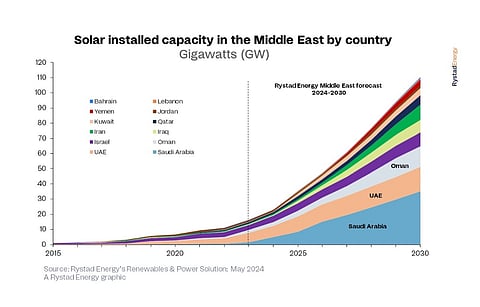

The total installed solar PV capacity of the Middle East at the end of 2023 exceeded 16 GW, and is set to scale up to 23 GW by 2024-end. By 2030, according to Norwegian market intelligence firm Rystad Energy, it will surpass 100 GW as the technology becomes increasingly important in the region's energy policies.
Known as the 'oil and gas powerhouse', the region generated 93% of its total electricity from fossil fuels till 2023-end with natural gas comprising 40% of the overall gas demand. Renewables accounted for only 3% and nuclear and hydro 2% each, according to Rystad's latest research.
It will continue to rely heavily on natural gas in the short term as its usage will peak around 2030.
The Middle East is encouraging renewable energy to respond to a global push towards reducing its carbon emissions. At the same time, population growth, further industrialization, the anticipated rise in electric vehicles (EV), and the need for freshwater desalination will increase the demand for power generation. It is expected to reach about 2,000 TWh, growing from 1,200 TWh at present.
This increased demand will be met by renewables as Rystad sees green energy sources outpacing fossil fuel use in the Middle East's power sector by 2040, led by solar PV. This clean energy technology is forecast to account for more than half of the region's power supply by the middle of the century, up from 2% in 2023.
Several countries in the Middle East now factor in solar energy in their energy policies. Saudi Arabia leads the charge as it targets 58 GW of solar PV capacity by 2030, expanding it from over 2.7 GW at present. It has already achieved the world record low levelized cost of electricity (LCOE) of $10.4/MWh.
At present, the announced solar projects account for about 13 GW in the country while ongoing auctions add another 5.5 GW. This leaves a gap of more than 18 GW, says Rystad's Renewables and Power Analyst Nishant Kumar.
Another promising solar market here is the UAE, which targets 14 GW capacity by 2030, up from 6 GW at present. The Mohammad Bin Rashid Al Maktoum Solar Park (MBR Solar Park) alone will represent 5 GW AC solar capacity by 2030.
Oman is yet another large market with about 700 MW solar capacity operational today and plans to increase the same to 3 GW in 2025, and 4.5 GW in 2030.
Moving further, Rystad analysts see renewable energy sources including hydro, solar and wind representing 70% of the region's power generation mix by 2050. At the end of 2023, it was a mere 5%, they share.
